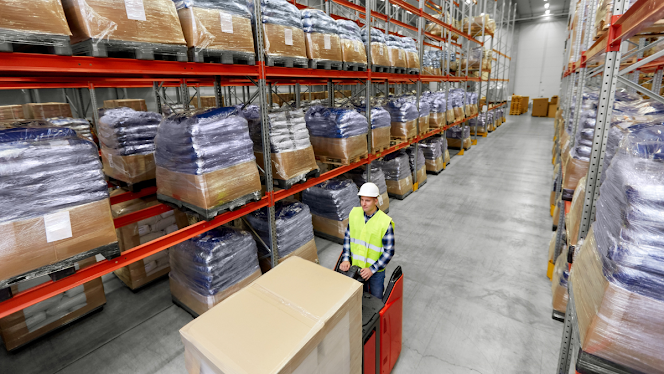Maximising Efficiency with Micro warehousing: How to Optimise Your Small-Scale Storage Operations
Micro warehousing is a relatively new concept in the logistics and warehousing industry. It refers to setting up small-scale storage facilities strategically located to enable faster and more efficient order fulfilment. This article will explore how micro warehousing can help you maximise efficiency in your small-scale storage operations.
 |
| Maximising Efficiency with Micro warehousing |
Advantages of Micro warehousing
One of the main advantages of micro warehousing is increased efficiency. Setting up small-scale storage facilities closer to your customers can reduce the distance and time required to fulfil orders. This can help you improve your order fulfillment times and customer satisfaction levels.
Another advantage of micro warehousing is cost savings. Traditional warehousing facilities are often located in remote areas where real estate is cheaper. However, this also means that transportation costs are higher, which can affect your profit margins. Micro warehousing facilities, on the other hand, are located in urban areas with lower transportation costs.
Finally, micro warehousing can help you achieve faster delivery times. By having storage facilities closer to your customers, you can reduce the time transporting goods from the warehouse to the end customer. This can help you deliver products faster, leading to higher customer satisfaction levels.
Factors to Consider When Setting Up a Micro warehouse
If you are considering setting up a Micro Warehouse, there are several factors that you need to take into account. One of the most important factors is location. You need to choose a location that is close to your customers and has good transportation links.
The layout and design of your Micro Warehouse are also important. You need to ensure that the space is organised to maximise efficiency and make it easy for your staff to pick up and pack orders. You also need to consider the equipment and technology you will need to operate your micro warehouse.
Implementing Micro warehousing in Your Small-Scale Storage Operations
Implementing micro warehousing in your small-scale storage operations requires careful planning and execution. One of the first steps is to develop a strategy that outlines your goals and objectives. This should include a detailed customer base analysis, order volumes, and delivery requirements.
You also need to hire and train skilled staff in operating micro warehousing facilities. This may include hiring staff who have experience working in similar facilities or providing training to your existing staff.
Choosing the right technology is also important when implementing micro warehousing in small-scale storage operations. This may include implementing a warehouse management system (WMS) to help you track inventory and orders, barcode scanners, and other automated systems.
Best Practices for Optimising Your Micro warehouse
To ensure that your micro warehouse is operating at maximum efficiency, there are several best practices that you can follow:
Utilising Vertical Space
One of the key ways to optimise your Micro Warehouse is by utilising vertical space. This means installing high shelving units and using mezzanine floors to create more storage space. By utilising vertical space, you can store more goods in a smaller footprint, which can help you save on real estate costs.
Implementing Lean Principles
Implementing lean principles can also help you optimise your micro warehouse operations. This involves streamlining your processes to eliminate waste and improve efficiency. This can include implementing a just-in-time (JIT) inventory management system, which can help you reduce inventory levels and save on storage costs.
Regularly Reviewing and Adjusting Your Processes
Finally, it is important to regularly review and adjust your processes to ensure that you are operating at maximum efficiency. This may involve analysing data from your warehouse management system and identifying areas where you can improve your processes. By continually reviewing and adjusting your processes, you can ensure that your Micro Warehouse operates at maximum efficiency.
Conclusion
In conclusion, micro warehousing is a powerful tool for optimising your small-scale storage operations. Setting up small-scale storage facilities closer to your customers can reduce the distance and time it takes to fulfil orders, which can help you improve your order fulfilment times and customer satisfaction levels. To ensure that your Micro Warehouse is operating at maximum efficiency, it is important to consider factors such as location, layout, technology and 4PL provider like Warehousity and to implement best practices such as utilising vertical space, implementing lean principles, and regularly reviewing and adjusting your processes.
FAQs
What is micro warehousing?
Micro warehousing is the practice of setting up small-scale storage facilities that are strategically located to enable faster and more efficient order fulfilment.
What are the advantages of micro warehousing?
The advantages of micro warehousing include increased efficiency, cost savings, and faster delivery times.
What factors should I consider when setting up a micro warehouse?
When setting up a Micro Warehouse, you should consider location, layout and design, and equipment and technology.
How can I implement micro warehousing in my small-scale storage operations?
To implement micro warehousing in your small-scale storage operations, you should develop a strategy, hire and train staff, and choose the right technology.
What are some best practices for optimising my micro warehouse?
Some best practices for optimising your micro warehouse include utilising vertical space, implementing lean principles, and regularly reviewing and adjusting your processes.
Related Links:
Bonded Warehouse in India | Dark Store or Warehouse | Decentralisation of Warehouse | Direct to Consumer (D2C) Fulfillment



Comments
Post a Comment